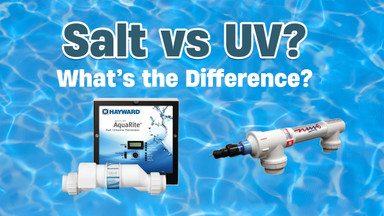Swimming Pool UV-Ozone Systems VS. Salt Chlorinators: What’s The Difference?
Published by EZ Pool & Spa Supply on 01/23/2019
Posted in: Chlorine Alternatives, Saltwater Systems, UV Sanitizers
Pool maintenance can be challenging, especially when it comes to keeping the pool water crystal clear.While there are numerous sanitization systems, the ones frequently inquired about are UV-Ozone systems and salt chlorinators. Here in this comparison article, we’ll establish the difference between the two systems, why they’re effective, and what drawbacks exist.
UV-Ozone Systems
UV-Ozone systems create a safe, enjoyable swimming experience. UV-Ozone systems function, by destroying what chlorine can’t normally in a pool. Chlorine can merely neutralize pathogens or bacteria. However, UV-Ozone can actually wipe out the DNA so that bacteria-pantherine can no longer grow. UV-Ozone also destroys algae growth during the sweltering summer season.
For UV-Ozone to work, it needs a low Chlorine residual (normally .5-1.0 CL PPM). UV-Ozone is eco-friendly, by reducing overall chemical use, safer for the environment and is recognized as a second sanitizer by most local health officials. This eliminates carrying and storing certain chemicals. UV-Ozone will reduce other pool parameters in a pool. It reduces the alkalinity, does not cause a rise in pH, which will eliminate the customer using acid and stabilizer. In addition, some UV-Ozone systems are easy to use and winterize.
There is a small drawback to UV-Ozone systems. The bulb needs to be cleaned with care. White vinegar is often recommended to scrub the bulb. Hands contain oils on fingertips which can ultimately smear over the bulb, thus, hampering its effectiveness. Also, you should not look directly at the bulb for prolonged periods of time. The bulbs need to replace every 2-5 years depending on usage. The price is around $ 150-250 approximate cost.
Currently, there’s no way to measure UV-Ozone production. The only way to determine its working is to see how the clear the water is and watch the chlorine reading. Or on some select systems, the power supply box on the pool’s pad and bulbs will be lit to indicate its operating.

Cost: UV-Ozone $899 - $1199 Salt Generators $899 - $1499
Salt Chlorinators or Chlorine Generators
Salt chlorination systems actually produce chlorine, despite contrary belief. The chlorine is produced in a drastically different way than a tablet feeder or liquid chlorine. Initially, it’s produced as a gas from a precious metal (ruthenium covered titanium in a series of plates). These plates create an electrolysis charges like a battery, with a positive and negative charge. The chlorine it produces creates “softer water,” therefore, the swimming experience is not full of chlorine odor, water tightness, bleaching/irritation of the skin, and scorching red eyes.
Salt readings are easy to read, comprehend, and control. Yet another reason why they’re widely popular. You can test the pool’s salt levels by choosing from a huge array of digital testers on the market. As a side note: test strips also provide quite accurate reads as well.
Salt will increase the PH, alkalinity, and calcium, so on the flipside, you’ll be utilizing more stabilizer and acid. Salt is corrosive and can be hard on any pool surface including fiberglass, concrete, and vinyl. In certain instances, salt can also be harmful to above ground pools with an aluminum or steel construct. Salt can be corrosive if the calcium is too high in the pool, causing blotchy rust spots to sprout on the walls or in a rebar inground pool. Intergrading an in-line zinc anode into the pool’s water does help.
Calcium can be problematic, but so are phosphates in the chlorine production, especially for salt chlorination systems. This is due to the fact; salt systems have to work harder to produce chlorine. Consequently, constant conflict between phosphates and chlorine will ensue, hurting the system’s ability to create chlorine. To combat this, we recommend that a pool owner use a phosphate remover.
Salt Chlorination systems are compatible with most automation systems in the market. We suggest getting this professionally installed versus self-assistance.
Handling the cleaning procedure of the salt cell is fairly easy. You must utilize an acid-water mixture (usually 1 to 4 ratio). When dealing with acid, be very wary of its corrosiveness. However, a safer way to clean the cell is with straight-up vinegar. This is efficient, granted, it takes longer for calcium to dissipate off the plates. Salt chlorination has been regarded as a popular option, there is a wide array to choose from.
Conclusion
We hope this article helps you understand the difference between Salt and UV Ozone. UV-Ozone systems and salt chlorinators each offer a different way to keep your pool safe and the pool water clear. When determining which system is best suitable for your pool, please take the following factors into consideration:
- What climate do you live in?
- What the design of the pool (inground or above ground) do you have?
- How much are you budgeted for?
- Please be advised of the cost for each system. This includes installation fees, maintenance work, supplies and chemicals imperative for running said systems, repairs, etc.



